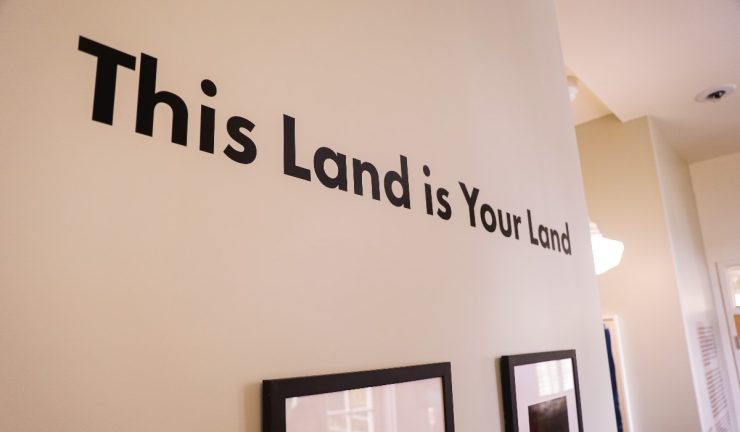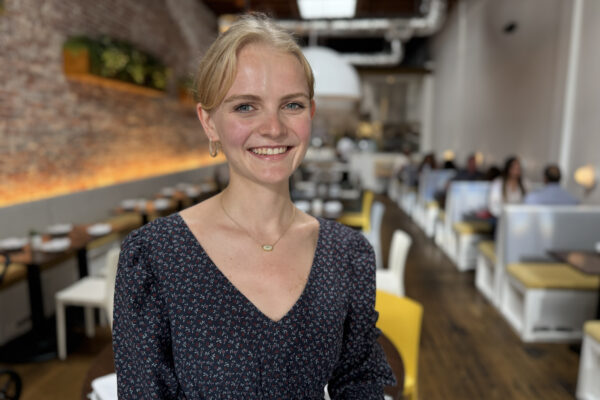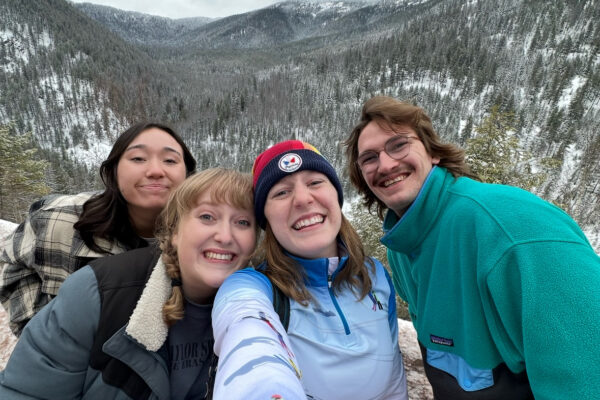An art exhibition spans the halls of Chapman University’s Roosevelt Hall, inviting viewers to consider the environmental wrongs perpetuated against the landscape.
Speakers present strategies for responding to oil spills along California’s coastline.
A book talk features a visit from the author, an environmental activist.
Those events could be a lineup on any university calendar. But at Chapman many are student-led activities and programs. First-year students dipped into a university art collection to curate that exhibition, others in an upper division course gave the oil spill talks to local community and nonprofit groups and a young alumna is the visiting author.
It’s all thanks to a wide-ranging initiative in Wilkinson College of Arts, Humanities, and Social Sciences called Engaging the World: Leading the Conversation. The annual program examines key societal issues through an interdisciplinary program of humanities courses, events, podcast, book discussions, guest speakers, visiting performers at Musco Center for the Arts and more.
The focus changes each year – this year is environmental justice. But built into each cycle of Engaging the World activities and related courses are opportunities for students to be the creators, doers and voices driving the dialogue. Alumni participate, too. Among the upcoming events is the Engaging the World Book Club featuring Leah Thomas ’17, author of “The Intersectional Environmentalist.”
Learning by Doing
Shifting the focus from conventional assignments sparks student experiences with real-world impact. That’s how first-year student Cassandra Chan ’25 found herself on a student team curating “This Land is Your Land,” an exhibition drawing on the irony woven into Woody Guthrie’s legendary song some have called an alternative national anthem. Chan proposed the title for the exhibition on display now in Roosevelt Hall and worked with other students in the First-year Focus Course (FFC) to select pieces from the Escalette Collection of Art.
Seeing it come to fruition was astounding, Chan said. She likened the experience of art curation to storytelling.
“It’s so amazing how many stories art pieces can hold,” she said.
The project includes social media components, a virtual exhibition along with the physical installation and student-recorded audio clips with each piece.
“The students worked very hard at learning how you create a conversation between artworks,” said Fiona Shen, Ph.D., director of the Phyllis and Ross Escalette Permanent Collection of Art and instructor of the Wilkinson FFC course that produced the exhibition.
The selections range from Prayers for Flint by Karen Hampton, a tapestry that memorializes the water crisis in Flint, Michigan, which sickened the majority-Black city, to photography by Laurie Brown, whose panoramic photos capture western landscapes on the cusp of change as housing development draws near.
“One of the interesting things was that on the surface, many of the works might look like pretty landscapes but they’re very much about environmental justice,” Shen said.
The Roosevelt Hall exhibition will be on display through October 2022. The virtual exhibition is available online.
‘Secondhand Smoke of the Sea’
Students in Environmental Advocacy Through Story also found a way to connect their coursework to the Engaging the World theme and share it with the community.
When an undersea pipeline spilled thousands of gallons of crude oil into the water off Orange County’s shoreline, course instructor Richelle Tanner, Ph.D., an assistant professor double appointed in Wilkinson and Schmid College of Science and Technology, asked the students if they’d like to create messaging tool kits to empower advocacy around oil spills.
The students embraced the additional assignment with gusto. The idea was to equip key community members and policymakers ranging from lifeguards to non-profits such as Orange County Coastkeeper with messaging kits they could use to educate their constituencies about oil spills, their hazards, and their actionable outcomes.
After studying the topics and the principles of science communication – a research interest of Tanner’s along with climate change – they developed graphics and posters to convey oil spills as the price of fossil fuel dependency, rather than as mishaps that can be quickly cleaned up.
They also created metaphors to help the public understand a spill’s long-lasting damage. For example, one team wrote “Oil spills are like the secondhand smoke of the sea” for lifeguards to use when warning swimmers away from oil-polluted waters.
Junior Berkana McDowell ’23 was on a team that crafted materials urging policymakers to include Indigenous peoples’ knowledge, perspectives and needs when problem-solving environmental situations.
Messaging Tool Kits Continue the Conversation
“Indigenous knowledge keepers are scientists without lab coats” was their metaphor. Inclusivity was their message.
“We can’t just use our Eurocentric and westernized perspectives of the world to solve these problems,” says McDowell, who identifies as a Black and Indigenous person of color.
Presenting the toolkits to a gathering of nonprofits at the semester’s end was a particular highlight, she said. From Tanner’s expertise in science communication, they had learned that the public trusts community leaders more than they do scientists. So to put information into those folks’ hands felt truly connected to the goal of Engaging the World.
“It’s so nice to be able to learn things that are so applicable to everyday life that can go straight into the field and connect with something that feels purposeful,” she said.




